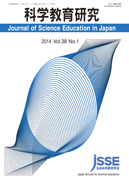All issues

Volume 24, Issue 3
Displaying 1-5 of 5 articles from this issue
- |<
- <
- 1
- >
- >|
-
Midori SUZUKI, Yoshisuke KUMANO, Robert E. YAGERArticle type: Research Article
2000 Volume 24 Issue 3 Pages 139-150
Published: September 10, 2000
Released on J-STAGE: June 30, 2017
JOURNAL FREE ACCESSThe purpose of this study was to inquire into the status of Science Literacy among the Japanese students. In this study an assessment and the authors' original questionnaire were undertaken. The former was an investigate the status of students' Science Literacy using 1996 Iowa Assessment Handbook(Liu, et.al., 1996)and the latter took place through an original questionnaire about the ideal scientist. The following two results were noted; for (1)The students lack the ability to make a presentation of their experiments to other people using appropriate methods. (2)There is a serious misconception among the students;they think that they do not have to be interested in science or to enjoy studying it in order to acquire Science Literacy.View full abstractDownload PDF (962K) -
Kyoko KAKIHANA, Katsuhiko SHIMIZU, Nobuhiko NOHDAArticle type: Research Article
2000 Volume 24 Issue 3 Pages 151-158
Published: September 10, 2000
Released on J-STAGE: June 30, 2017
JOURNAL FREE ACCESSThe purpose of this research is to identify students' and teachers' conception of the effects of Dynamic Geometry Software (DGS) and to find similarities between this identification of their conception and other research findings. Teachers' and students' opinions/impressions from 31 teaching reports of Cabri classes of 15 teachers ware analyzed. The results were as follows (1)In the affective aspect, students recognized they could learn and enjoy geometry more actively, especially in exploratory activities, as many researchers have reported. (2)In the cognitive aspect, students recognized their understanding of what they learned and found. (3)In expectation, students worked in DGS classes as teachers had expected how they do. Teachers' expectations were mostly the same as the effects that had been reported by researchers. (4)The same problems regarding DGS classes were pointed out both by teachers and researchers.View full abstractDownload PDF (727K) -
Young-suk LEE, Nobuhiko NOHDAArticle type: Research Article
2000 Volume 24 Issue 3 Pages 159-169
Published: September 10, 2000
Released on J-STAGE: June 30, 2017
JOURNAL FREE ACCESSEducational practice and research have aroused increasing interest in learning based on a small-group setting. However, much of the literature related to mathematical problem solving in a small-group setting merely reports achievement results. It disregards the study of the process that takes place during small group work to determine how various academic, social, or psychological effects are produced. Therefore, this paper focuses upon the dynamic process of collaborative mathematical problem solving. To analyze the process of collaborative mathematical problem solving, this study develops a rationale for discourse analysis, elaborates the theoretical process-observation framework focusing on the emergent goals perspective, and conducts a case study which was undertaken by one pair of college-age women working on the"painted cube"problem.View full abstractDownload PDF (1029K) -
Tetsuo HORIArticle type: Research Article
2000 Volume 24 Issue 3 Pages 170-178
Published: September 10, 2000
Released on J-STAGE: June 30, 2017
JOURNAL FREE ACCESSThe purpose of this study is to provide examples of the development of assessment approaches for students'abilities. For this purpose, first I sort out problems with assessment approaches that previous researches have suggested so far. At the same time, I suggest sevral viewpoints we should take into consideration to cultivate that kind abilities. After that, I give concrete examples of the development of education of evaluation methods for that ability. Next, I suggest three types of assessment approaches of the ability of problem solving:the limited type(type A)within the situation in question, the free type(type B)from the situation in question, and the method of having students make a self-evaluation, using A or B assessment types(type C). Then I give examples in which we adapted these three types to concrete teaching contents and discuss advantages and disadvantages of each type application.View full abstractDownload PDF (808K) -
Tetsuo NAKAGAWAArticle type: Research Article
2000 Volume 24 Issue 3 Pages 179-186
Published: September 10, 2000
Released on J-STAGE: June 30, 2017
JOURNAL FREE ACCESSAn alternative procedure of estimating partial molar volumes for binary sulutions is proposed. Although the concept of the partial molar volume is important in physical chemistry, the method of its estimation has been mainly introduced in textbooks, as a graphical procedure, namely, a method of intercepts. Such a graphical method often yields imprecise values. Instead the partial molar volumes can be derived via the corresponding excess molar volumes using the Redlich-Kister equations. Moreover, the values are evaluated for the ethanol-ethylene glycol and t-amyl alcohol-toluene solutions at25℃ using the available data measured by Loucks. It has been found that our alternative procedure provides more precise partial molar volumes than Loucks', and is useful for general binary solutions. These findings will help chemistry students learn the meaning of partial molar volume.View full abstractDownload PDF (477K)
- |<
- <
- 1
- >
- >|